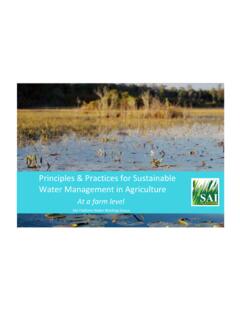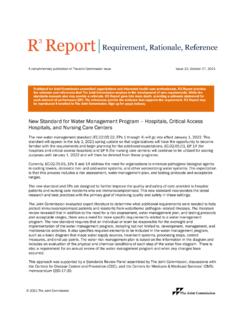Transcription of STORMWATER WET POND AND WETLAND
1 STORMWATER WET POND AND WETLAND MANAGEMENT GUIDEBOOK Based on material originally produced by: Center for Watershed Protection 8390 Main Street, Second Floor Ellicott City, MD 21043 With assistance from: Tetra Tech, Inc. 10306 Eaton Place Suite 340 Fairfax, VA 22030 Under: EPA Contract 68-C-99-253 Revised by EPA February 2009 Table of Contents Table of Contents ..ii 1 2 Section 1: Wet Pond and WETLAND Challenges and Opportunities .. 5 5 water quality Impacts .. 5 Habitat 5 Health and Safety Issues .. 5 Aesthetics .. 6 Maintenance Problems .. 7 17 Section 2: Inspection and Maintenance of Existing Ponds and Wetlands .. 19 19 Inspectors .. 19 Inspection 20 Inspection Checklists .. 21 Documentation of Inspection Findings.
2 21 ROUTINE 23 MAINTENANCE 26 Maintenance Activity Profile Sheets .. 27 M-1 PERMANENT 28 M-2 31 M-3 PIPE 33 M-4 VEGETATION 38 M-5 DREDGING AND MUCK 42 M-6 45 M-7 MECHANICAL 47 M-8 NUISANCE 50 Animals .. 50 Waterfowl .. 51 Mosquitoes .. 52 Undesirable Plant Communities .. 53 water quality Degradation .. 54 References .. 56 Appendix A: Unit Costs for Pond and WETLAND Maintenance Appendix B: Pond and WETLAND Checklists LIST OF TABLES Table : Mechanisms of Pipe Failure .. 11 Table : Inspection Skill Level Descriptions .. 19 Table : Typical Inspection/Maintenance Frequencies for Ponds And Wetlands .. 20 Table : Maintenance Activities and Schedules .. 23 Table : BMP Maintenance Skill Level 26 Table : Permanent Pool Fluctuation 29 Table : Common Pipe Uses, Material, and Maintenance Concerns.
3 33 Table : Limitations of common pipe rehabilitation methods .. 37 Introduction Introduction Prior to 1991, a relatively small number of states and municipalities had formal programs in place requiring that Best Management Practices (BMPs) be constructed to mitigate runoff pollution. Then, beginning in the early 1990's with the advent of Phase I of the federal National Pollutant Discharge Elimination System (NPDES) STORMWATER program, many additional municipalities began programs to limit STORMWATER pollution. These programs typically include the installation of public and private wet ponds and wetlands as tools to help control runoff volume and mitigate pollution from runoff and, as a result, many of these BMPs have been constructed throughout the United States.
4 Unfortunately, the push to construct them has been substantially stronger than the push to actively maintain them. The current federal STORMWATER regulations ( , Phase I and Phase II NPDES rules) require permitting authorities and permittees to address BMP operation, maintenance, and retrofit as a major programmatic component. In addition, as we learn more about the limitations and challenges inherent in these types of one size fits all approaches to STORMWATER management, retrofit opportunities are being considered and implemented across the country in order to better address water quality issues, aesthetics, and the maintenance of existing hydrology. For more information regarding retrofitting BMPs, see the Urban Subwatershed Restoration Manual No.
5 3: Urban STORMWATER Retrofit Practices Manual (Schueler, 2007) available at The primary audience for this Guidebook is Phase I and Phase II NPDES communities. For Phase I communities that may have a maintenance program in place, this Guidebook provides technical data and information to help improve existing design standards or inspection and maintenance standards. The Guidebook provides a technical resource for both Phase I and Phase II NPDES communities. This Guidebook provides the inspector, program manager, designer, and owner ( , responsible party) with an understanding of common STORMWATER pond and WETLAND maintenance problems and possible solutions. None of the maintenance solutions mentioned in this Guidebook are required by federal regulations, but they are meant to help those involved in maintaining these BMPs.
6 This Guidebook has been developed expressly to assist communities in developing an integrated STORMWATER management system which includes proper maintenance of existing wet ponds and wetlands, the exploration of retrofit opportunities, as well as the implementation of micro-treatment practices and low impact development design principles. A set of web-based tools was produced to accompany the Guidebook and can be found on the STORMWATER Manager s Resource Center (SMRC) website ( , click on Program Resources then STP Maintenance). This Guidebook does not address the maintenance needs of dry ponds or underground detention. These practices are not widely recommended as stand alone practices that provide water quality and water quantity benefits.
7 Dry ponds, however, exist in many communities, as flood control facilities, and many of the maintenance considerations for STORMWATER ponds and wetlands presented in this Guidebook are relevant to dry ponds. 1 Terminology Terminology STORMWATER management terminology is often confusing and can convey multiple meanings. This Guidebook uses several terms throughout the text that merit upfront explanation and definition to provide the reader with a foundation for the understanding the context of the subsequent text. Barrel The closed conduit used to convey water under or through an embankment: part of the principal spillway. Channel Protection Volume (Cpv) Storage volume for the control of downstream channel erosion. Emergency Spillway A dam spillway designed and constructed to discharge flow in excess of the principal spillway design discharge.
8 Extended Detention (ED) Design feature that provides for the gradual release of a volume of water to increase settling of pollutants and protect downstream channels from frequent storm events. Forebay Additional storage space located near a STORMWATER practice inlet that serves to trap incoming coarse sediments before they accumulate in the main treatment area. Micropool Small permanent pool used to avoid resuspension of particles and minimize impact to adjacent natural features. Overbank Flood Control, ( , Peak Discharge Protection Volume (Qp) Storage volume needed to control the magnitude of flows associated with larger, out of bank flooding events ( , 10-year return frequency storm events). Permanent Pool Open area of water impounded by a dam, embankment or berm, designed to retain water at all times.)
9 Pond Drain A pipe or other structure used to drain a permanent pool within a specified time period. Principal Spillway The primary pipe or weir that carries baseflow and storm flow through the embankment. Riser A vertical pipe which extends from the bottom of a pond STORMWATER practice and houses the control devices (weirs/orifices) to achieve the discharge rates for specified designs. Shallow Marsh Human-made WETLAND with water depths ranging from <6 to 18 , planted with native WETLAND vegetation. STORMWATER Ponds (Figure A) practices with a permanent pool, or a combination of extended detention (ED) or shallow marsh with a permanent pool that provides storage equivalent to the entire water quality Volume (WQv). STORMWATER ponds may also provide channel protection storage volume (Cpv) and overbank flood control (Qp) through STORMWATER detention above the WQv storage.
10 Pond design variants include micropool ED ponds, wet ponds, wet ED ponds, and multiple pond systems. STORMWATER wetlands (Figure B) shallow marsh areas that treat urban STORMWATER , and often incorporate small permanent pools and/or extended detention storage to achieve the full WQv. STORMWATER wetlands may also provide peak discharge control (Qp) and channel protection storage volume (Cpv) through 2 Terminology STORMWATER detention above the WQv storage. WETLAND design variants include shallow marsh, ED/shallow marsh, and shallow marsh/wet pond. water quality Volume (WQv) Storage volume needed to capture and treat runoff associated with smaller, frequently occurring storms ( , 1 rainfall depth). Figure A: STORMWATER Pond Schematic 3 Terminology 4 Figure B: STORMWATER WETLAND Schematic Section 1: Wet Pond and WETLAND Challenges and Opportunities Section 1: Wet Pond and WETLAND Challenges and Opportunities Challenges water quality Impacts STORMWATER ponds and wetlands are designed and constructed to contain and/or filter pollutants that flush off of the landscape.












